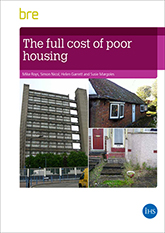The full cost of poor housing
On 19 May 2016, BRE published a new report revealing that poor quality homes in England cost the NHS £1.4bn and wider society £18.6bn per year.
Although diseases associated with the slums of Victorian Britain have been largely eradicated, there remain a significant number of health and safety hazards in many homes, and this problem is compounded by the fact that the UK has some of the oldest housing stock in the developed world.
The report ‘The Full Cost of Poor Housing’ presents the findings from a research project funded by the Department of Communities and Local Government (DCLG) and the BRE Trust, to update and improve estimates of the cost to the NHS of living in poor housing. It updates an earlier report ‘The Real Cost of Poor Housing’, published in 2010.
The new report is aimed at surveyors, housing policy analysts and policy makers, town planners, housing managers in the public and private sector, landlords, property owners, health professionals and managers. It expands on the 2010 report’s model, calculating costs and benefits associated with the main building-related hazards found in homes in England, using the latest published data on health and safety in the home and updated NHS treatment costs. The definition of poor housing has also been expanded to include all sub-standard housing, not just those with serious hazards.
The research suggests that the cost to the NHS from injuries and illness directly attributable to homes in poor condition is £1.4bn per year. The wider cost of leaving poor quality housing in England unimproved (including medical costs, lost education and employment opportunities) is £18.6 billion per year.
The report’s lead author Mike Roys said: “The revised model expands the costs to the NHS to include wider societal costs such as medical costs, lost education and employment opportunities.”
Dr Ann Marie Connolly, Deputy Director, Health Equity and Mental Health at Public Health England said: “We welcome this report which adds to existing evidence and our wider understanding of the link between poor housing, demands on NHS care and associated social costs. We hope this report will stimulate wider discussions and local action to address the important role that good housing plays in underpinning the health and wellbeing of the people of England.”
To find out more, see the BRE Bookshop.
[edit] Related articles on Designing Buildings Wiki
- 100 years of council housing.
- A measure of net well-being that incorporates the effect of housing environmental impacts.
- Accessibility in the built environment.
- Changing lifestyles
- Creating strong communities – measuring social sustainability in new housing development.
- Decent Homes for Ageing Well.
- Decent homes standard.
- Healthy Homes Act.
- Quantifying the health benefits of the Decent Homes programme FB 64.
- The cost-benefit to the NHS arising from preventative housing interventions (FB82).
- The cost of poor housing to the NHS.
- The design of extra care housing for older people and its impact on wellbeing: The East Sussex perspective.
- The full cost of poor housing in Wales.
- The Housing Stock of The United Kingdom.
- The real cost of poor housing.
- Well-being and regeneration: Reflections from Carpenters Estate.
- Wellbeing.
- What's the condition of your housing stock?
Featured articles and news
RTPI leader to become new CIOB Chief Executive Officer
Dr Victoria Hills MRTPI, FICE to take over after Caroline Gumble’s departure.
Social and affordable housing, a long term plan for delivery
The “Delivering a Decade of Renewal for Social and Affordable Housing” strategy sets out future path.
A change to adoptive architecture
Effects of global weather warming on architectural detailing, material choice and human interaction.
The proposed publicly owned and backed subsidiary of Homes England, to facilitate new homes.
How big is the problem and what can we do to mitigate the effects?
Overheating guidance and tools for building designers
A number of cool guides to help with the heat.
The UK's Modern Industrial Strategy: A 10 year plan
Previous consultation criticism, current key elements and general support with some persisting reservations.
Building Safety Regulator reforms
New roles, new staff and a new fast track service pave the way for a single construction regulator.
Architectural Technologist CPDs and Communications
CIAT CPD… and how you can do it!
Cooling centres and cool spaces
Managing extreme heat in cities by directing the public to places for heat stress relief and water sources.
Winter gardens: A brief history and warm variations
Extending the season with glass in different forms and terms.
Restoring Great Yarmouth's Winter Gardens
Transforming one of the least sustainable constructions imaginable.
Construction Skills Mission Board launch sector drive
Newly formed government and industry collaboration set strategy for recruiting an additional 100,000 construction workers a year.
New Architects Code comes into effect in September 2025
ARB Architects Code of Conduct and Practice available with ongoing consultation regarding guidance.
Welsh Skills Body (Medr) launches ambitious plan
The new skills body brings together funding and regulation of tertiary education and research for the devolved nation.
Paul Gandy FCIOB announced as next CIOB President
Former Tilbury Douglas CEO takes helm.
UK Infrastructure: A 10 Year Strategy. In brief with reactions
With the National Infrastructure and Service Transformation Authority (NISTA).
























